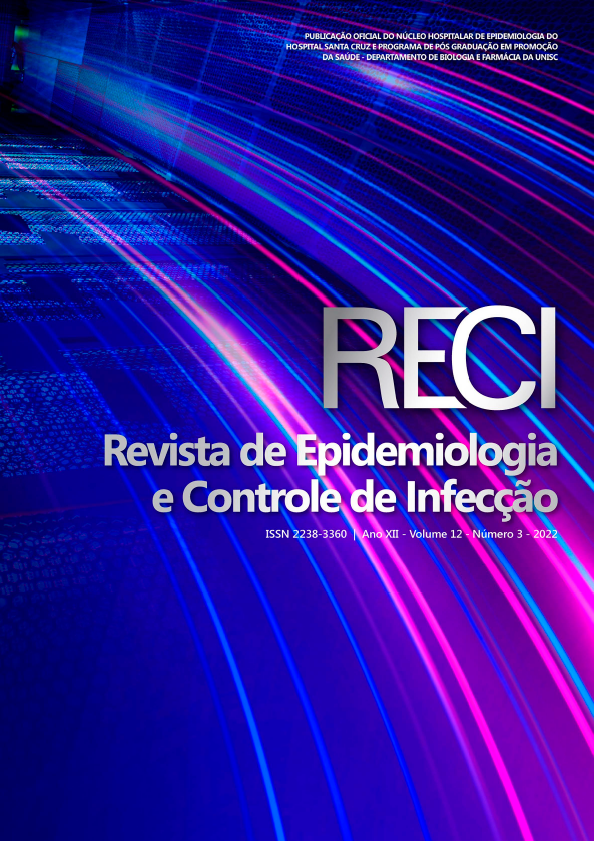Sensitivity profile of blood culture isolates in a clinical analysis laboratory, Fortaleza, CE
DOI:
https://doi.org/10.17058/reci.v12i3.16822Keywords:
Bacteremia, Hemocultura, Resistência Bacteriana, Perfil de Sensibilidade.Abstract
Background and objectives: bacteremia is defined from the presence of bacteria in the bloodstream. Its clinical importance is associated with the high morbidity and mortality rate in the world. In severe cases, it can culminate in sepsis, with a constant increase in cases in Brazil. Therefore, this study aims to assess the main bacterial isolates in blood cultures and a possible change in their sensitivity profiles in a clinical analysis laboratory in Fortaleza, Ceará. Methods: an epidemiological, descriptive, retrospective study was carried out, with a quantitative approach of positive blood cultures, seeking to assess the main isolated microorganisms and their sensitivity profiles. The data used were obtained from the laboratory system through the EpiCenter® software, from January 2019 to December 2020. Statistical analysis was performed using the Graphpad 7.0 software. Results: 840 microorganisms were identified from blood cultures, and the main ones were E. coli, K. pneumoniae, P. aeruginosa, S. epidermidis, S. aureus and S. haemolyticus. Some isolates show a change in the sensitivity profile, such as K. pneumoniae and P. aeruginosa, showing an increase in sensitivity to carbapenems and cephalosporins, while S. epidermidis showed a decrease in sensitivity to minocycline in the comparison between years 2019 and 2020.Conclusion: clinical isolates from blood cultures showed a change in the sensitivity profile between 2019 and 2020, taking into account that, for K. pneumoniae, P. aeruginosa, this change resulted in an increase in sensitivity, with an increase in resistance in S. epidermidis isolates.
Downloads
References
Farfour E, Si Larbi AG, Cardot E, et al. Impact of rapid diagnostic tests on the management of patients presenting with Enterobacteriaceae bacteremia. Médecine Et Maladies Infectieuses. 2019; 49 (3): 202-207, https://doi.org/10.1016/j.medmal.2018.11.015
Lobo SM, Rezende E, Mendes CL, et al. Mortality due to sepsis in Brazil in a real scenario: the Brazilian ICUs project. Revista Bras de Terapia Intensiva. 2019; 31 (1): 1-4. https://doi.org/10.5935/0103-507x.20190008
Global Sepsis Alliance, Sepsis, Common causes, 2020: https://www.global-sepsis-alliance.org/sepsis
Joshi S. Hospital antibiogram: a necessity. Indian Journal Of Medical Microbiology. 2010; 28 (4): 277-280. https://doi.org/10.4103/0255-0857.71802
Pai S, Enoch DA, Aliyu SH. Bacteremia in children: epidemiology, clinical diagnosis and antibiotic treatment. Expert Review Of Anti-Infective Therapy. 2015; 13 (9): 1073-1088. https://doi.org/10.1586/14787210.2015.1063418
Martinez RM, Wolk DM. Bloodstream Infections. Microbiology Spectrum. 2016; 4 (4): 1-34, https://doi.org/10.1128/microbiolspec.DMIH2-0031-2016
Sabino SS, Lima CA, Machado LG, et al. Infections and antimicrobial resistance in an adult intensive care unit in a Brazilian hospital and the influence of drug resistance on the thirty-day mortality among patients with bloodstream infections. Revista da Sociedade Brasileira de Medicina Tropical. 2020; 53:1-4. https://doi.org/10.1590/0037-8682-0106-2019
Frieri M, Kumar K, Boutin A. Antibiotic resistance. Journal Of Infection And Public Health. 2017; 10 (4): 369-378, https://doi.org/10.1016/j.jiph.2016.08.007.
Zhang G, Feng J. The intrinsic resistance of bacteria. Yi Chuan. 2016;38(10):872-880. https://doi.org/10.16288/j.yczz.16-159
Watkins RR, Bonomo RA. Overview: global and local impact of antibiotic resistance. Infectious Disease Clinics Of North America. 2016; 30 (2): 313-322, https://doi.org/10.1016/j.idc.2016.02.001
Vivas R, Barbosa AA, Dolabela SS, et al. Multidrug-Resistant Bacteria and Alternative Methods to Control Them: an overview. Microbial Drug Resistance. 2019; 25 (6): 890-908. https://doi.org/10.1089/mdr.2018.0319
Duval RE, Grare M, Demoré B. Fight Against Antimicrobial Resistance: we always need new antibacterials but for right bacteria. Molecules. 2019; 24 (17): 1-9. https://doi.org/10.3390/molecules24173152.
Brazilian Committee on Antimicrobial Susceptibily Testing, BRCast. Orientações do EUCast/BRCast para a detecção de mecanismos de resistência e resistências específicas de importância clínica e/ou epidemiológica. Versão 9.0. Fevereiro de 2019.
Dallacorte TS, Indras DM, Teixeira JJ, et al. Prevalence and profile of antimicrobial sensitivity of bacteria isolated from blood culture performed at private hospitals. Rev Inst Adolfo Lutz. 2016; 75 (1): 1-11. http://www.ial.sp.gov.br/resources/insituto-adolfo lutz/publicacoes/rial/10/rial75_completa/artigos-separados/1702.pdf
Oliveira WV, Santos WS, Gomes BS, et al. Etiologia e perfil de susceptibilidade dos microrganismos isolados de hemoculturas no Hospital das Clínicas da UFPE no período de janeiro a dezembro de 2014. RBAC. 2019; 51 (1): 40-45.
https://doi.org/10.21877/2448-3877.201900755
Cunha MN, Linardi VR. Incidence of bacteremia in a tertiary hospital in eastern Minas Gerais. Revista de Med. Minas Gerais. 2013; 23(2): 146-150, http://www.dx.doi.org/10.5935/2238-3182.20130024
Downloads
Published
How to Cite
Issue
Section
License
Copyright (c) 2022 André Luis Alves Filho

This work is licensed under a Creative Commons Attribution 4.0 International License.
The author must state that the paper is original (has not been published previously), not infringing any copyright or other ownership right involving third parties. Once the paper is submitted, the Journal reserves the right to make normative changes, such as spelling and grammar, in order to maintain the language standard, but respecting the author’s style. The published papers become ownership of RECI, considering that all the opinions expressed by the authors are their responsibility. Because we are an open access journal, we allow free use of articles in educational and scientific applications provided the source is cited under the Creative Commons CC-BY license.


